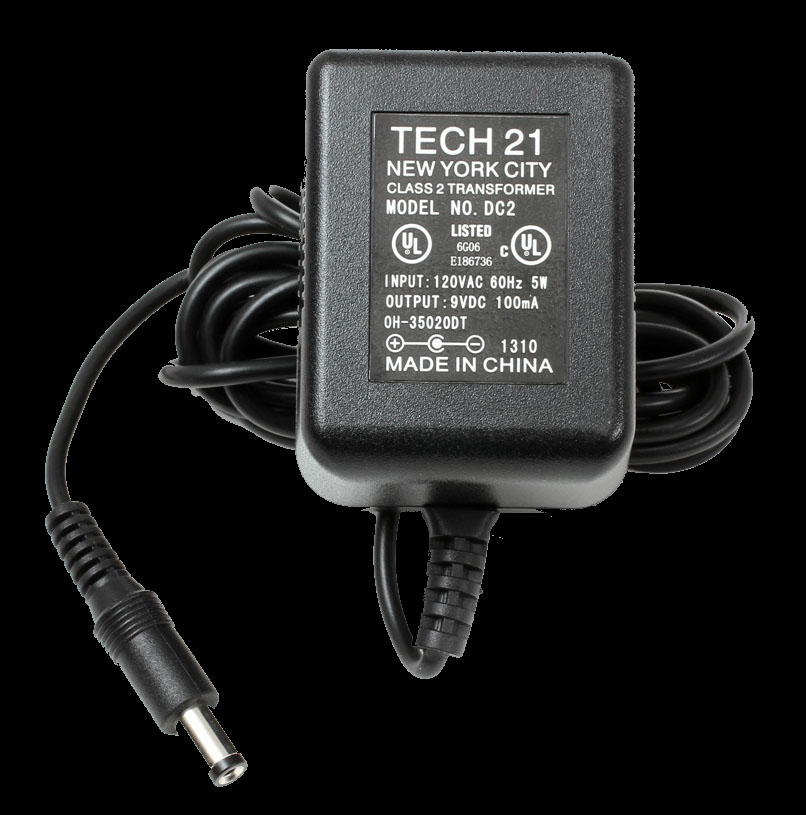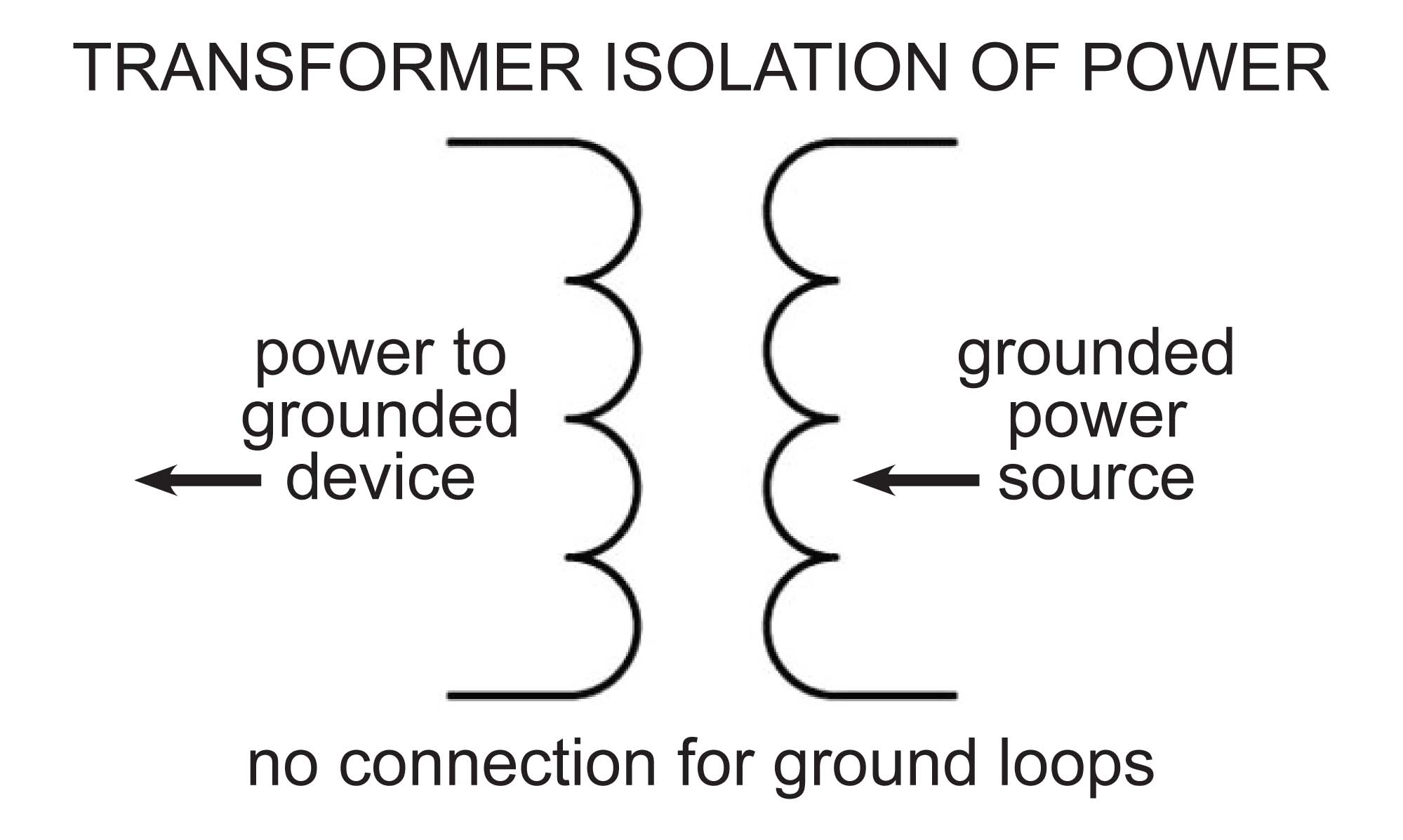|
|
|
|
.
About Powering Pedals
.
|
Powering pedals can be tricky. If not done properly, it can become the prime source of noise in a rig. This page will help you design power for your pedals that is reliable, quiet, and economical.
|
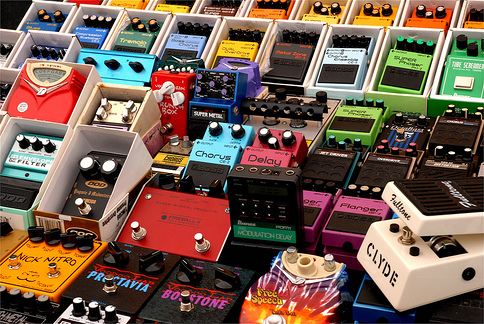 |
.
First: A Look at the State-of-the-Art Power Solution
|
.
If you wish to use PedalSnake as your only cable, with no AC power cord to run, and keep a pro-grade power supply on your pedalboard, the 24V Method is the way to go. Adopt this method, and it's all you need to know.
|
|

|
.
If you wish to find out more about powering pedals, including the most economical methods, read on ... |
|
Back to top
What You Need to Know About Powering Pedals
.Power Chaining is Fine (When Done Right)
How To Avoid Ground Loop Hum
Don't Overload
Pedal Voltages
Voltage Polarities
Power Supply Current Ratings
Power Plug Sizes
Other Helpful Resources
Use Good Power Supplies (yes...wall warts are fine) |
|
|
Good power supplies are needed for quiet audio, but you do not have to spend $175 on a board-mounted, multi-output supply. If you can afford to do that, that is OK. They can solve a lot of problems for you, and save you time and effort. But they have a downside.
The downside is, apart from the unnecessarily high cost, is that an expensive board mounted supply will hog space and add weight to your pedalboard. But...and this is important...they force you to continue running the big AC power cord to your pedal area--even after you switch to PedalSnake. This prevents the ideal "one cable solution" achieved with PedalSnake's Low Voltage Method. |
|
|
|
Contrary to popular belief, standard power supplies made for pedals are actually true isolated Class 2 Transformers (aka "wall warts") are as quiet as a battery when used properly.
Wall warts earn their funny name because of the size and weight of the transformer. But being big and clunky is a small price to pay for a quiet iron-core transformer. This is the only way to isolate power, and keep ground loop hum from sneaking in. Supplies with many isolated outputs have essentially many small wall warts inside. The outputs come off a coil of wire on one large isolated transformer. |
|
|
|
There are some good power supplies out there now that are smaller, and can put out lots of current (over 1000mA in some cases). But these are not true isolated transformers. They weigh a lot less than a true iron transformer, and can be a bit noisier than a transformer-based wall wart.
|
|
|
|
Here are some guidelines to follow to ensure that you use wall warts quietly:
|
|
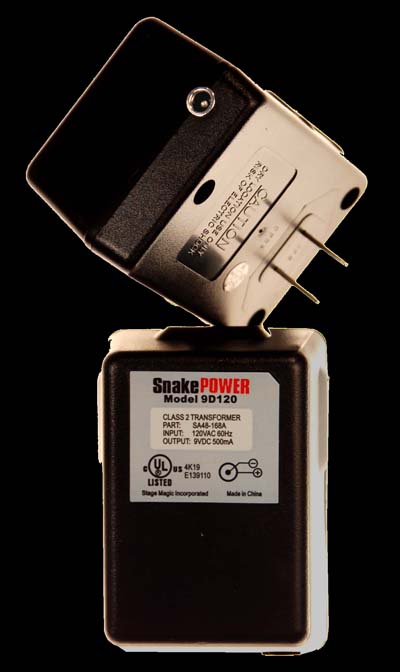 |
Most wall warts deliver 200mA or so, only enough power for 4-6 stompboxes (9V battery pedals) on a power chain.
|
|
|
To improve this situation, we introduced SnakePOWER . At 500mA, it is the most powerful isolated wall wart on the market. It will power a dozen or more 9V pedals, which can cut down on the number of P-Lines you need if and when you switch to PedalSnake.
|
|
|
|
How do you know how many pedals can be powered from one wall wart? See Don't Overload below.
|
|
Power Chaining is Fine (When Done Right) |
|
|
|
A good way to make efficient use of power supplies is to chain power to several pedals from one power supply (or output). But please note, power chaining applies mainly to the "lo current" 9V pedals. You know, the small pedals that don't come with a power supply, and often have a 9V battery option inside. |
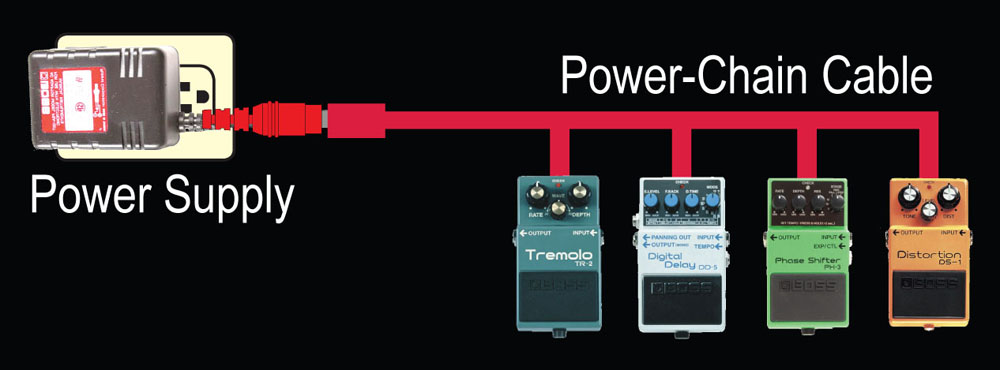 |
|
Guidelines for Quiet, Reliable Power Chaining
|
|
This can be most any good "wall wart" from a reputable pedal maker, or an output from a multi-output supply with individually isolated outputs. Isolation usually involves a "transformer", where power is induced from coil-to-coil across a gap, with no actual electrical connection.
. Don't Get Fooled
In a good professional multi-output supply, each output is isolated from the other outputs. Some makers try to fool you by implying this when it is not true. They may say "isolated outputs", but the outputs are only isolated as a group. All of their grounds are still tied together, which is merely a glorified power chain (and less expensive to make). Look for the phrase "individually isolated outputs".
NOTE: This is not true of the Strymon power supplies. They have solved the issue with magnetic fields. See this very cool video, where someone discovered you can "sniff" for magnetic fields with an ON wah pedal: https://www.youtube.com/watch?v=YCiHaqOdJ-A )
NOTE: PedalSnakes Low Voltage Method places power supplies at the backline, entirely off your pedalboard. This is the quietest solution (unless you use Strymon supplies).
NOTE: This is why PedalSnake devoloped the Vari-Chain Power Chain System, the world's only power chain system with configurable length. You design it for the exact number of pedals you need to power, with no unused plugs left over. Vari-Chain also sports all spacing-saving right-angle plugs.
NOTE: The most common source of ground loop hum is with FX Loops. Not all amps require this, but it is a good rule of thumb to isolate Amp Input pedals from FX Loop pedals by powering them with separte isolated outputs (or separate Class 2 wall warts.)
|
|
|
How To Avoid Ground Loop Hum |
|
|
In pedal rigs, ground loop hum can occur if the wrong things get hooked together without proper isolation.
|
|
Isolate Stereo Amps
|
|
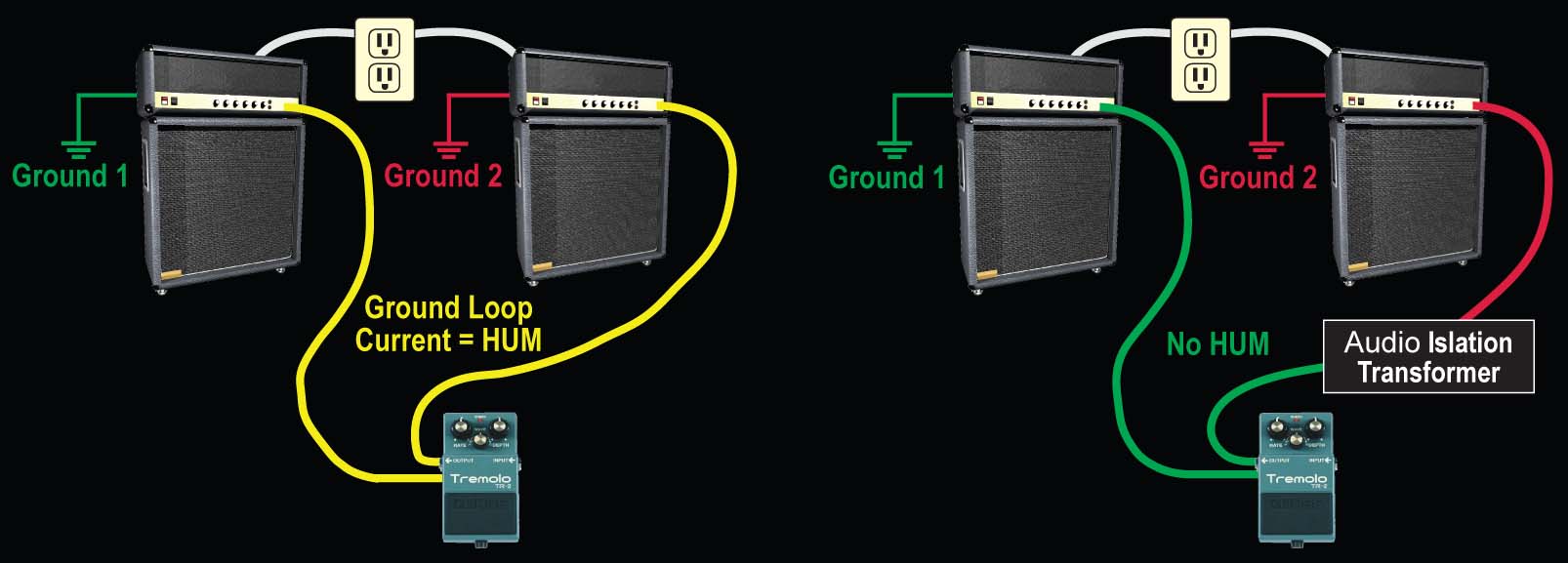 |
|
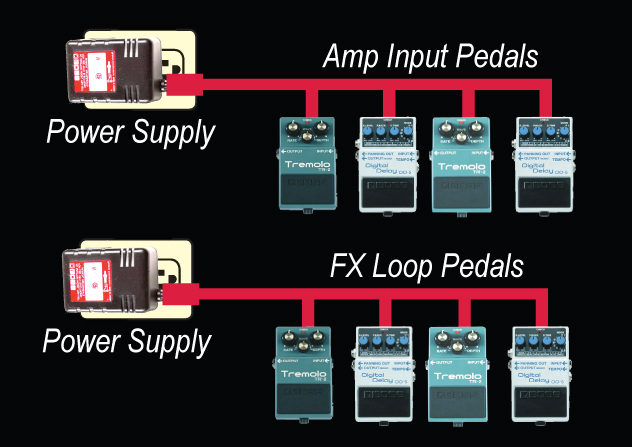 |
Isolate FX LoopsAlthough rare, some powerful all-tube amps with FX Loops can have different ground potentials with the same metal chassis! So powering front end pedals and FX Loop pedals with the same power supply can sometimes result in a bit of ground loop hum.
Even though it doesn't make much difference with most amps, it is a good practice to use a separate isolated supply for Amp Input Pedals and FX Loop Pedals. For more about this, see Isolating Power Chains. This article is found on the page about general Isolation and Grounding.
|
|
|
Don't Overload |
|
|
|
Every power supply has its limit, which is called its current rating. The average 9V stompbox draws about 20mA of current. But this varies widely, from 1mA to 75mA (we are talking about stompboxes that have the option for a 9V battery. These draw very little current.) If too many pedals are power chained from one supply, a supply can overload, causing hum, or have a shorter life from overheating.
|
|
|
|
A Good Rule of ThumbTwo "9V battery" stompboxes per 100mA of current rating for the supply.
So a 200mA supply is usually good for 4 pedals. This is conservative. A typical 200mA power supply will usually power 4-6 9V pedals safely and quietly. But be aware, 9V battery pedals can vary widely in how much current they draw; anywhere from 1mA to 75mA.
NOTE SnakePOWER is rated 500mA, and will power a dozen or more. If you can get a reasonable estimate of how much current your pedals are drawing, then you can may be able to safely add more pedals. Basically, it is best not exceed 50% of the supply's current rating. If push comes to shove, 75% is fine with most supplies, but the more you load them down, the hotter they run, and this shortens their life. If you actually exceed the current rating of the supply, you will usually know it from bad buzz or hum. .
How do you know how much current is being drawn by a pedal?
You can try to find out from the manufacturer, but that can be a joke with some companies. Stinkfoot.se has a good website with a Power List. You can try to find your pedals on his list.
|
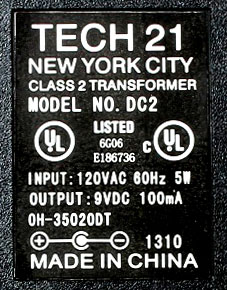 |
Pedal Voltages
|
Every pedal has a specific operating voltage. The most popular operating voltage is 9VDC. Pedals that take 9V batteries operate at 9VDC, but they can usually be powered with a 9DVC power supply too. A pedal's voltage is usually printed at it's power input connector, like "9VDC". Remember, "DC" voltage is different from "AC" voltage. If not on the pedal, look for the voltage on its power supply, like "OUTPUT: 9VDC". If it just says "9V", with no "DC" or "AC", it is probably DC. |
 |
|
|
|
|
|
|
|
|
|
Voltage Polarities |
|
|
|
The standard voltage polarity is "center-negative", which (unfortunately) was not a good idea for the industry to adopt (read why here). A little diagram like this is usually printed on the power supply. If you use a standard center-negative supply, and you wish to power-chain it to a center-positive pedal (that is +9VDC), you will need a 21RP Reverse Polarity adapter for that pedal. |
 |
|
|
NOTE Some pedals that say "center-positive" really have ground at the center, and run on -9VDC instead of +9VDC. We know this is confusing, and fortunately not many pedals run on -9VDC. They are mostly germanium fuzzes it seems. But if you have one, you can't add it to a power chain using 21RP. You must power it by itself with a separate supply. Use a center-positive supply, or use a center-negative supply with 21RP added to reverse the polarity.
|
|
Back to Top |
||
Power Supply Current RatingsSometimes this gets confused with how much current a pedal actually draws---that is usually only a fraction of the power supply's current rating. You can usually see the current-rating printed on the power supply---look for something like "Output: ..200mA". This tell you how much current the supply can safely deliver before it starts to hum. But, before it starts to hum, it can overheat, which can shorten its life expectancy. See Don't Overload. So, to not overload the supply when power-chaining pedals from one supply, it is good to know (or estimate) the real current draw of the pedals. They add up, and a good rule of thumb, to have your supply last a long time, is to not exceed 50% of the power supply's rating. If push comes to shove, you can go up to 75%, but just beware that the total current draw matters. |
 |
|
|
|
Power Plug SizesThe standard size for a pedal power jack is 2.1mm. Some pedals have other sizes. These are usually pedals that take some voltage other than 9V (but not always).The 2 most common non-standard power plug sizes are 2.5mm (Digitech, Line 6, Eventide, etc.), and 3.5mm (1/8" miniphone plug, used by older DOD, Electro-Harmonix, etc.) PedalSnake offers Power Plug Adapters the for 2 non-standard sizes. How to tell the difference is shown below. |
|
2.1mm ( x 5.5 ) standardThis is the standard size used by stompboxes from Boss, Dunlop, etc. PedalSnake P-Lines, as well as most any power-chain cable, use the standard 2.1. |
 |
2.5mm ( x 5.5 )2.5 is hard to tell from 2.1, but there are ways:
|
 |
3.5mm (1/8" mini-phone connector)These are easy to see----the male plug is like the 1/8" miniphone plug on portable headphones, and unlike a female barrel connector, the 3.5 jack has no "pin" inside. |
|
Other Helpful Resources
Guitar Noise Manual
Isolation and Grounding
Power Plug Adapters List
PedalSnake® is the trademark name for Stage Magic's All-in-One Pedal Cabling Solution. Copyright © 2012 Stage Magic, Inc.


